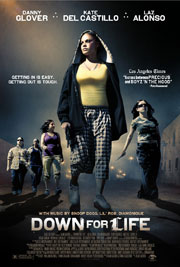 “If you’re gonna fight for something, it should be for something better than this.” Those are the words of Rascal – the 15-year-old leader of a Latina gang clique – explaining why she’s leaving her life of violence. Alan Jacobs’ film, “Down for Life,” follows the story of Rascal (played by newcomer and Manual Arts High School alumna Jessica Romero) on the day she tries to wrench herself from gang life. It also shows why many never leave: The journey is deadly.
“If you’re gonna fight for something, it should be for something better than this.” Those are the words of Rascal – the 15-year-old leader of a Latina gang clique – explaining why she’s leaving her life of violence. Alan Jacobs’ film, “Down for Life,” follows the story of Rascal (played by newcomer and Manual Arts High School alumna Jessica Romero) on the day she tries to wrench herself from gang life. It also shows why many never leave: The journey is deadly.
The film draws from the story of Lesly Castillo, a former gang affiliate whose essay for a ninth-grade class became the subject of a 2005 New York Times article, “Essays in Search of Happy Endings.” In “Down for Life,” Rascal chronicles her experience in an application essay for a writing program in Iowa, which she and her teacher Mr. Shannon (Danny Glover) hope will get her out. If only it were that easy. It’s hard to write while constantly on the run.
Romero and many of the young women Jacobs recruited for the film are South Central L.A. residents with no acting experience. What they lack in thespian training, they make up for in real-life gang knowledge. Like the grainy footage, the casting strikes an uneasy balance of reality and fiction. The perspective is fresh and hyper-local.
Early on, Rascal and her fellow bangers fight a rival girl-gang of black youngsters for turf near Locke High School. The close-ups of their hands and faces brutally illustrate that this is not some group of girls pulling each other’s hair and scratching each other’s arms. These are hardened fighters on a mission, battling for this small stretch of pavement.
Later, they initiate a new member in an auto repair shop run by the gang’s boss, a psychopathic creep named Flaco (Cesar Garcia). He rapes the new recruit as part of her initiation while the viewer sees close-ups of the mechanics disassembling a stolen Pontiac GTO, possibly to symbolize the machinery of the gangs and the idea of a life systematically being taken apart and reassembled.
All the institutions in the children’s lives – family, education, law enforcement and the gang’s sisterhood – fail them. Rascal flees her home because of her abusive father and seeks refuge with her friend Vanessa (Emily Rios) in Chatsworth. She teaches the valley girls a bit about how to talk and act like gangsters. It’s both scary and quaint to them. But not even Chatsworth can provide a home for Rascal.
The only person who seems to understand what’s really happening to Rascal is Mr. Shannon. He believes she has a gift for writing. More importantly, he believes she has a future, as long as she can extricate herself from the gang scene. Mr. Shannon has to fight to get the school’s principal to approve her nomination for the Iowa program.
“Come on, Lee. She’s representing our school,” the principal tells him.
“Accurately, I would say,” he replies.
Though she has her teacher behind her, Rascal ultimately has to choose to break out. The teacher is less of a savior than a coach. The film’s tension comes not from the question of whether she will get into the Iowa program, but whether she will live to enjoy it.
Iowa represents a fresh start, far removed from L.A.’s vortex of violence. “Down for Life” is less about changing the failing institutions and more about escaping them. The film makes for a harrowing adventure and a magnified look at these girls’ despair, but what is most disturbing is the implied message: If you’re searching for a happy ending, don’t look in South Central.















